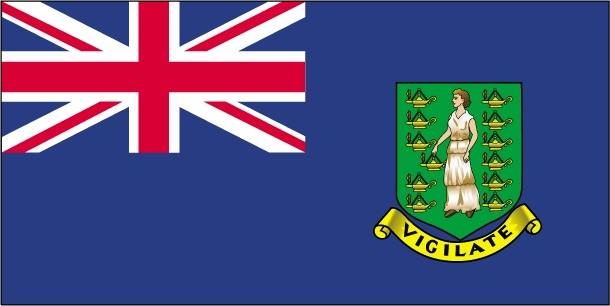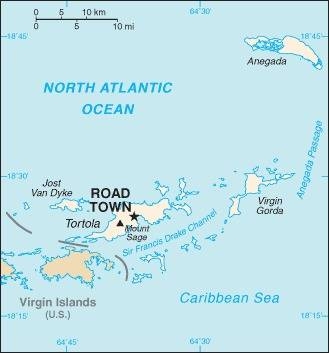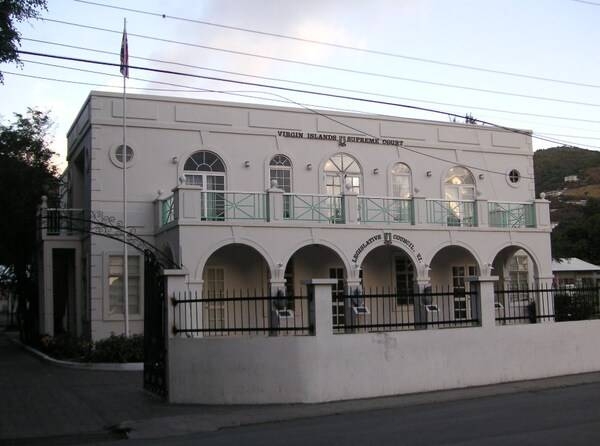117 British Virgin Islands (UK)

Blue with the flag of the UK in the upper hoist-side quadrant and the Virgin Islander coat of arms centered in the outer half of the flag. The coat of arms depicts a woman flanked on either side by a vertical column of six oil lamps above a scroll bearing the Latin word VIGILATE (Be Watchful). The islands were named by COLUMBUS in 1493 in honor of Saint Ursula and her 11 virgin followers (some sources say 11,000) who reputedly were martyred by the Huns in the 4th or 5th century. The figure on the banner holding a lamp represents the saint. The other lamps symbolize her followers.
Flag courtesy of the CIA World Factbook

Map courtesy of the CIA World Factbook

The former Legislative Council Building in Road Town is today used as the House of Assembly and the High Court.
Photo courtesy of the CIA World Factbook
Last updated on March 20, 2025
Government
According to Britannica, the British Virgin Islands are a British overseas territory. The country is administered under a constitution that came into effect in 2007 and provided greater internal self-government. The chief executive officer is the governor, who is appointed by the British monarch. The premier is a member of the House of Assembly (formerly the Legislative Council) who is elected by the body’s majority party and then appointed by the governor. The premier presides over a cabinet comprising four other ministers and the ex offico attorney general. The House of Assembly consists of 13 members elected by universal adult suffrage; a speaker, who is elected from outside the council by its members; and the attorney general.
Organization of Eastern Caribbean States (OECS)
The Organization of Eastern Caribbean States (OECS) is an eleven-member grouping of islands spread across the Eastern Caribbean. Together, they form a near-continuous archipelago across the eastern reaches of the Caribbean Sea. They comprise the Leeward Islands: Antigua and Barbuda, Saint Kitts and Nevis, Montserrat, Anguilla and the British Virgin Islands; and the Windward Islands: Dominica, Saint Lucia, Saint Vincent and the Grenadines and Grenada, Martinique and Guadeloupe.
Eastern Caribbean Civil Aviation Authority (ECCAA)
The Eastern Caribbean Civil Aviation Authority (ECCAA) evolved from the Directorate of Civil Aviation – Eastern Caribbean States, which may be considered as one of the oldest, if not the oldest institutions in the Eastern Caribbean region. From inception, the Directorate was seen as a vehicle for facilitating a collective and uniform approach to Civil Aviation matters affecting the then Windward and Leeward Islands, which now comprise the OECS Group.
Airspace
SkyVector – Google Maps – ADS-B Exchange
ICAO countries publish an Aeronautical Information Publication (AIP). This document is divided into three parts: General (GEN), En Route (ENR) and Aerodromes (AD). ENR 1.4 details the types of airspace classes they chose to adopt from classes A through G.
BVI AIP – fee required
Drone Regulations
Drone Users Are Subject To Aviation Rules – Government of the British Virgin Islands
ASSI – Legal requirements for the operation of small unmanned aircraft in the UK Overseas Territories
Advanced Air Mobility (AAM) Regulations & Policies
None found by the author.
However, should you, the reader, happen to stumble across something to the contrary, please email the author at FISHE5CA@erau.edu and you may be mentioned in the ACKNOWLEDGEMENTS section of this book by way of thanks for contributing to this free eBook!
Advanced Air Mobility (AAM) News
None found by the author.
However, should you, the reader, happen to stumble across something to the contrary, please email the author at FISHE5CA@erau.edu and you may be mentioned in the ACKNOWLEDGEMENTS section of this book by way of thanks for contributing to this free eBook!
Short Essay Questions
Scenario-Based Question
You have been hired by a Drone Startup Company. Your boss has immediately assigned this job to you.
They need you to prepare a one-page memo detailing the legalities of using a drone to film the High Court building, pictured above.
They need you to mention any national laws and local ordinances.
They specifically want to know what airspace (insert pictures) you will be operating in and whether or not you need an airspace authorization.
Does it matter whether or not you are a citizen of the country?
Lastly, there is a bonus for you if, as you scroll through this chapter, you find any typos or broken links!
Short Essay Questions
- What are the drone categories?
- How is registration addressed?
- How is remote ID addressed?
- What are the model aircraft rules?
- What are the commercial drone rules?
- Are there waivers or exemptions to the rules? If so, for what?
- Would you share a link to an interactive airspace map?
- How is BVLOS addressed?
- How can you fly drones at night?
- How can you fly drones over people?
- Where do you find drone NOTAMs?
- What are the rules for drone maintenance?
- What are the rules for an SMS program?
- What are some unique rules not mentioned above?
- What are the C-UAS rules?
- What are the AAM rules?

